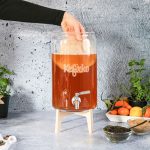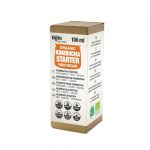KOMBUCHA MAKING

See answers to FAQs about kombucha below.
“SCOBY” is actually an acronym: Symbiotic Culture Of Bacteria and Yeast. The gelatinous base forms on the liquid interface where liquid connects to air. The cultures we use for fermenting tea produce a pancake-sized structure that also looks like the top of the mushroom. Also, this gave it a nickname “mushroom” or “tea mushroom” and sometimes also “kombucha mother”.
To prepare 1l kombucha, you need a cup of strong tea )250 ml) (black/green/white), sugar or honey and kombucha scoby, jun scoby or kombucha starter. Secondly, you would need about 700 ml of water to dilute the tea. Also, you can make 900 ml of tea to begin with but it will take longer to cool off. You will also need 100 ml of kombucha from previous batch (or starter culture). You can prepare kombucha in any large glass jar with lid – 1,4 l Kefirko kefir fermenter is good option.
Get supplies for fermenting
A glass or ceramic jar are the best choice to ferment kombucha. Glass is perfect for many reasons, mainly because you can easily clean it and it does not react with acid in kombucha. You can also use it continuously for brewing kombucha, which means you do not empty it and clean it between the batches.
Kombucha is a probiotic drink made with fermentation. As with other probiotic drinks, it’s best if it’s homemade with hand picked ingredients.
Properties of “tea of life”
Studies have shown that it has bioactive components with antioxidant and detoxifying effect. It also shows antimicrobial properties because of the low pH, around 2.5. Low pH is not the only reason for antimicrobial impact. The natural polyphenols in tea, bacteriocins and protein structures also play a role in this.
Beneficial probiotic drink
These support the claims that this beverage has a befinical effect on overall immunity, mental health and even cancer or cardiovascular disease prevention. Probiotics in kombucha aid with gut health and general well-being. Supposedly it has positive influences on immunity, obesity, cardiovascular disease, atherosclerosis, hypertension, anemia, pulmonary disease, antioxidant capabilities and cancer prevention.
Start fermenting now
Like with all fermentation, it’s important to use clean equipment. This also means thoroughly washing your hands and all the equipment that will get in touch with kombucha. Sterilisation is also recommended but it’s not necessary as long as you maintain cleanliness and hygiene.
Ingredients for 1 l kombucha:
- 2 bags of tea (2 tsp tea leaves)
- 50g sugar
- 900 ml water
- 100 ml kombucha starter or SCOBY and 100 ml kombucha from previous batch
To make kombucha you need to prepare ingredients first. Boil one cup of water and put in 2 tea bags or 2 tsp of tea leaves. Leave for 5 minutes then take out the leaves or tea bags. Cool down and stir in 50g of sugar. You can use honey if you are preparing jun kombucha. Pour into the glass jar and dilute with remaining water. Add starter or 0,1 l of kombucha from previous batch and SCOBY. Leave to ferment as per manufacturer instructions, 7-14 days.
When using kombucha starter …
If you are using the starter, pour in the 0,1 l of starter into the sweetened tea (900 ml). The scoby will start to form during the first fermentation. You have to leave it to ferment a bit longer, for 10-14 days.
Always save 0,1 l of ferment or 10% of the amount you are planning to prepare. It’s used for storing the scoby and for preparing the new batch.
Start brewing with Kefirko
You don’t have to brew 1l of tea if you plan to prepare 1l kombucha. You can brew a small amount of tea then dillute it with the rest of the water. This will also help you to cool it off faster.
Just note, the tea has to be a lot more stronger than you would usually make and if you make even more (2l or 4l) of kombucha you have to adjust the quantities of the tea also.
Prepare kombucha with Kefirko:
You can use many different sugars or even honey to prepare kombucha. Each of them will give a unique taste and texture of your beverage so you just have to decide which suits you best.
Our cultures are fermented with organic white sugar, but you can use brown, raw sugars instead that have more molasses. This will in turn give a more darker color to your kombucha and it will taste different too. You can also make jun kombucha with honey and green tea. This one has a more mild taste and light color of beverage.
Recommended temperature for making kombucha is between 21 and 25 degrees (C). Lower temperatures will slow down the fermentation and higher temperatures will speed it up. Higher temperatures are also optimal for yeast development, which you can see as brown strains on the SCOBY and in kombucha as well. Too much yeast in kombucha changes the balance and affects the taste too.
No. Microbes in kombucha need sugar to ferment. This is serve as food for them and the result is a probiotic drink that is so beneficial for you. Note, the sugar in kombucha is for the microbes not for you.
You can add sweeteners or stevia to sweeten your beverage before drinking.
You can prepare your first batch of kombucha using only kombucha starter liquid. Starter kombucha is actually kombucha that was fermenting a bit longer and is very sour. Basically, it’s not good to drink anymore but the acidity is just perfect to make a new batch of kombucha with it.
You can follow the kombucha recipe and prepare kombucha, adding the proper amount of starter liquid – it needs at least 10 % of the whole amount. During fermentation SCOBY will start to form on the surface of the liquid. This usually happens some time after day 7 of fermentation. After fermentation is finished you will preserve part of the kombucha drink and the newly formed SCOBY to use it for the next batch of kombucha.
Kombucha is traditionally made with black or green tea (or oolong) or sometimes a combination of both. Even other kinds of tea are supposedly fine to brew kombucha with and people are being successful with that. But in the long term brewing with pure black and/or green tea gives best results in taste and beneficial effect of kombucha and produces healthiest cultures.







